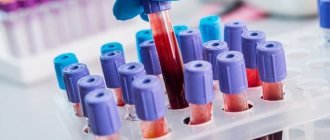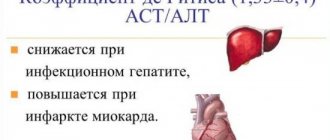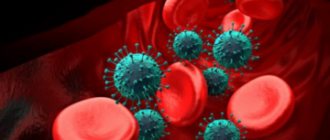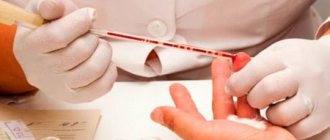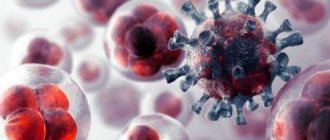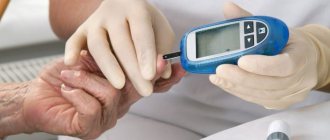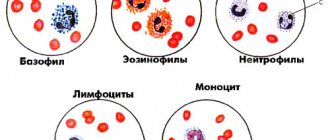A slight decrease in the number of leukocytes does not affect health and may have physiological reasons. If the process becomes chronic, the patient's immune system suffers and the following symptoms appear:
- Low-grade fever
- General weakness
- Frequent ARVI
- and fatigue
- Enlarged lymph nodes
- Increased sweating
- Tachycardia or heart pain
In the presence of serious diseases that cause leukopenia, an enlargement of the spleen and liver and even life-threatening septic shock are observed. In some cases, the disease is asymptomatic, and a decrease in the number of white blood cells is discovered by chance during a blood test. If leukopenia lasts more than 14 days, one of its symptoms is often a severe viral infection. If the disorder lasts for more than 6 weeks, the addition of a viral disease is observed in 100 percent of cases, which requires immediate treatment.
When identifying the cause of leukopenia, doctors are faced with two options for the development of the pathology. In the first case, there is an increased consumption of leukocytes and their destruction. In the second, there is a decrease or cessation of the production of white blood cells. Since leukopenia itself is not a disease, the symptoms of this pathology in patients in both groups will differ and depend on the main diagnosis.
A decrease in the formation of leukocytes may be due to the following reasons:
- Autoimmune diseases (systemic lupus)
- Bone marrow cancer or presence of metastases
- HIV infection and AIDS
- Conditions after irradiation for cancer
- Long-term deficiency of B vitamins, whose absence affects the composition of the blood
If the synthesis of leukocytes is impaired, the doctor may prescribe a special diet or correct the condition with medications. If we are talking about damage to the immune system or cancer of the bone marrow, therapy should be exclusively medicinal, supplemented by chemotherapy, radiation and other measures necessary to destroy malignant cells.
In some cases, the doctor may suspect general intoxication of the body, when living in an industrial area or places with an unfavorable environment leads to a constant supply of microdoses of heavy metals or toxins. Complete disappearance of leukocytes from the vascular bed can be observed during serious injuries, when white blood cells accumulate at the “gate” of entry to infection.
A slight deviation from the norm can be caused by an inflammatory disease, in the process of fighting which white blood cells die. A significant decrease in their number, as well as an increase, indicate an ailment that needs to be identified and treated promptly.
White blood cell norm for adults
For women and men, these indicators are slightly different, but remain in the range from 4 to 9x10 9 / l. A slight increase in the level of white blood cells in healthy women is observed during pregnancy and menstruation.
Deviations from normal values may also be associated with factors such as overwork, severe stress, swimming in a body of cold water or visiting a steam room immediately before taking a blood test. Overeating or eating hot and spicy foods can affect the number of white blood cells.
Norm of leukocytes for children
In childhood and adolescence, normal levels of leukocytes correspond to the table:
- newborns: 8-24.5 units.
- 1 month: 6-19 units.
- 6 months: 5.5-17 units.
- 1 year: 6-17.5 units.
- 2 years: 6-17 units.
- 4 years: 5.5 -15.5 units.
- 6 years: 5-14.5 units.
- 8 years: 4.5 -13.5 units.
- 10 years: 4.5-13 units.
- 16 years: 4 -13 units.
The most likely reason for a slight change in the number of leukocytes in children and adolescents is acute respiratory infections and colds, in which these indicators most often reach 8-9 units.
If, as a result of a blood test, the patient has been confirmed to have leukopenia, the main treatment is directed not at eliminating symptoms, but at identifying and treating the underlying disease. The following diagnostic measures help to establish it: ultrasound of the thyroid gland and abdominal organs, and analysis of cerebrospinal fluid.
If it is necessary to increase the production of white blood cells, drugs containing carboxylic acid and pyramidin are prescribed - Leukogen, Methyluracil. They not only stimulate the production of white blood cells, but also help with wound healing, poisoning, infections and radiation exposure.
HIV-infected patients are prescribed immunostimulants, such as Camedon and Immunol. If the cause of the pathology is associated with the spinal cord and malignant blood diseases, chemotherapy is prescribed, as well as “aggressive” drugs Filgrastim or Leucomax, which are administered intravenously in a hospital setting.
Secondary leukopenia, caused by accelerated consumption and destruction of leukocytes, requires treatment of diseases that inhibit the differentiation processes of white blood cells:
- Stop taking medications such as Amidopyrine, Sulfadimizine, Analgin and the like, which reduce the level of leukocytes.
- Hormonal therapy for thyroid diseases.
- Taking B vitamins and folic acid.
- Treatment of existing bacterial and viral infections.
You can “stimulate” the immune system with the help of Eleutherococcus tincture or the drug Immunal, which are safe and help stimulate the production of leukocytes.
Traditional medicine has many means to combat low levels of leukocytes. This therapy is aimed not only at accelerating the production of white blood cells, but also at fighting infections, increasing immunity and improving blood composition due to the necessary enzymes.
The following compounds act as immunostimulants:
- A drink made from chicory, hawthorn fruit, rose hips and wheatgrass root, taken in equal parts and prepared in a water bath.
- An infusion of strawberry leaves, nettles and rose hips.
- A decoction of motherwort, nettle and plantain seeds.
- Flower pollen with natural honey, 1 teaspoon on an empty stomach.
You can purify the blood and improve its composition in the following ways:
- Using beet kvass.
- Oat decoction.
- Juice from young bean pods.
Such medicinal folk remedies as a herbal collection of horsetail, knotweed and motherwort, propolis tincture, and wormwood decoction can be considered to be generally strengthening and have an effect on the body as a whole.
A folk remedy such as tincture of propolis and wormwood will help quickly restore the functions of the spinal cord. 2 tbsp. spoons of herbs are poured with half a liter of boiling water and infused. After filtering, add 20 drops of alcoholic infusion of propolis and drink 150 ml half an hour before meals.
The following composition will be a valuable help: mix freshly squeezed juice of carrots, beets and black radish in equal quantities. Pour it into a clay pot and simmer for half an hour in the oven. Drink 50 ml. three times a day, chilled.
Medicines
The methods used to combat leukopenia depend on its causes. In cases where the number of leukocytes is sharply reduced after chemotherapy, it can be raised to normal in just a few days with the following drugs:
- Pantoxyl. Promotes cellular regeneration and stimulates leukocyte production.
- Leukogen. It has minimal toxicity and does not accumulate in the body.
- Methyluracil. Helps cell restoration and has an effect already in the first 7 days of use.
- Neupogen. It is a composition of 175 amino acids, recommended after “chemistry”.
- Lenograstim for subcutaneous injection to improve hematopoiesis.
It is strictly contraindicated to prescribe such medications on your own; they should be selected by a hematologist and oncologist.
Foods that lower and increase white blood cell levels
To restore and improve the health of patients with leukopenia, a special diet is recommended, consisting of foods that increase the production and prolong the life cycle of leukocytes:
- Fruits and vegetables, especially red ones.
- All kinds of greens.
- Seafood and sea fish.
- Nuts.
- Cereals (buckwheat, oats).
- Low-fat dairy and fermented milk products.
You should limit all fatty and difficult-to-digest foods: meat, fried foods, smoked foods, as well as baked goods and baked goods. Among the drinks, beetroot and pomegranate juice, green smoothies, fruit drinks made from sea buckthorn, lingonberries and currants are extremely useful. It should be remembered that the diet only complements drug treatment and in no case can replace it. If it is necessary to reduce the level of leukocytes, then you should not only adhere to a healthy diet, but also drink linden blossom tea, eat sloe berries, and avoid alcoholic beverages and, in particular, beer.
Role of leukocytes
Leukocytes make up a group of blood cells along with red blood cells and platelets. These uncolored blood cells are responsible for immunity. They are able to detect pathogens penetrating from the outside and destroy them, as well as fight internal pathological processes.
The leukocyte group consists of five types of cells: lymphocytes, monocytes, neutrophils, basophils and eosinophils.
The first two belong to agrunolocytes, that is, they do not have granules in the cytoplasm. The rest are granular and are called granulocytes.
Each type performs specific functions:
- Neutrophils are the most numerous group (from 47 to 72%). In the blood of a healthy person, mainly mature forms (segmented) and very few young forms (band) circulate. Their main purpose is to fight harmful bacteria. They immediately respond to bacterial infection, which is expressed by an increase in the number of young forms in the blood. Neutrophils have the ability to quickly move through the body, accumulate in affected tissues, capture pathogenic microbes and destroy them.
- Basophils are the largest granulocytes. Their content in the blood normally ranges from 0.5 to 1%. They perform different functions, but the main one is participation in the formation of inflammation and immediate allergic reactions (for example, anaphylactic shock). This is possible due to the fact that their granules contain many bioactive chemicals - mediators of inflammation and allergies. These are serotonin, histamine, heparin, prostaglandins, leukotrienes and others.
- Eosinophils are able to move quickly, penetrate beyond the vascular wall and carry out phagocytosis, but their main property is cytotoxic. They take an active part in the fight against parasitic infections and in the formation of antiparasitic immunity. In addition, they can both absorb and release allergy mediators, that is, they can both suppress an allergic reaction and cause it.
- Lymphocytes are the main immune cells of the body, which make up from 25 to 40% of the total number of leukocytes. They are responsible for cellular and humoral immunity. Lymphocytes produce antibodies against harmful agents. These are the main fighters against viral infections and cancer cells.
- Monocytes are the largest white cells, the content of which in healthy people ranges from 3 to 11%. These macrophages perform several functions, but the main one is phagocytic defense against microbes.
Types of leukocytes
Leukocytes have a complete nuclear structure and, depending on the shape of the nucleus, they are divided into round, multilobular and kidney-shaped. They are also distinguished by size, which ranges from 6 to 20 microns. In the human body, white blood cells are produced by the bone marrow. They are divided into granular leukocytes (granulocytes), neutrophils (band and segmented), basophils and eosinophils, as well as monocytes and lymphocytes.
Leukocytes have a complete nuclear structure and, depending on the shape of the nucleus, they are divided into round, multilobular and kidney-shaped. They are also distinguished by size, which ranges from 6 to 20 microns. In the human body, white blood cells are produced by the bone marrow. They are divided into granular leukocytes (granulocytes), neutrophils (band and segmented), basophils and eosinophils, as well as monocytes and lymphocytes.
Causes of increased leukocytes
The most common causes of leukocytosis:
- Infectious diseases accompanied by fever: pneumonia, bronchitis and others.
- Viral lesions: hepatitis, rubella and others.
- Otitis is an inflammatory disease of the ear.
- Meningitis is an inflammation of the lining of the brain.
- Acute intestinal inflammation.
- Acute infections: appendicitis, pyelonephritis, cholecystitis and others.
- Purulent processes: abscess, peritonitis and others.
- Any inflammatory processes, for example, arthritis.
- Tissue damage, for example, due to trauma, wounds, surgery.
- Parasitic infections.
- Dehydration of the body, accompanied by thickening of the blood, for example, with burns, diarrhea.
Less commonly, white blood cells increase in the following cases:
- with myocardial infarction (an increase in the level of white cells is a reaction to the death of heart muscle tissue);
- leukemia (stable leukocytosis for a long time);
- malignant tumors;
- removal of the spleen;
- infectious mononucleosis;
- renal failure;
- massive bleeding;
- blood transfusion.
- The growth of neutrophils is observed with bacterial and fungal lesions.
- Lymphocytosis – for viral infections, thyrotoxicosis, mononucleosis, intoxication, lymphocytic leukemia, recovery from certain infections.
- Eosinophilia is a sign of helminthic infestations, dermatosis, bronchial asthma, and serum sickness.
- Monocytes are elevated in rubella, syphilis, septic endocarditis, and malaria.
The severity of the disease is assessed by the degree of increase in leukocytes. In this case, it is also necessary to take into account age, since in the elderly leukocytosis can be mild even with severe infections.
How to reduce?
If during a blood test it was discovered that the level of white cells is elevated, the question may arise about how to lower it. But leukocytosis itself is not considered a disease; it is just a sign of some disease, the body’s reaction to a pathological process. Therefore, first of all, you need to be examined and find the cause of this condition. Thus, in order to lower white blood cells, you need to cure the disease that led to their increase.
If the cause is an inflammatory process, the doctor will prescribe anti-inflammatory drugs. If the infection is bacterial, antibiotics will help. For viral diseases, antiviral agents are indicated, and for helminthiasis, antiparasitic agents are indicated. If leukocytosis is associated with allergies, antihistamines will come to the rescue.
If the increase is associated with physiological reasons, such as rich nutrition, physical activity, stress, then nothing special needs to be done. This increase in white cell levels is considered normal and will be regulated naturally.
Leukocytosis can be observed in pregnant women. As a rule, this is due to increased immune defense in the body and does not require correction. But at the same time, pathological causes cannot be excluded. Therefore, in case of any deviations from the norm in the blood test of the expectant mother, it is necessary to clarify whether this change is associated with the development of the disease. During this period, only a doctor can choose the safest method of treatment.
Causes and dangers of leukocytosis
An increased level of leukocytes “speaks” of the presence of infection in the body
Leukocytes are produced in the spinal cord and are needed to protect the body from various diseases. Their number is almost never the same. Under various types of stress they increase - with diseases, disorders of the central nervous system, with physical activity, etc.
There can be many reasons for the development of this disease, let’s consider the most popular:
- damage to muscle and osteochondral tissues due to injuries, fractures or mechanical damage
- acute course of an infectious disease
- chronic inflammatory processes
- poor diet and lifestyle disorder
- prolonged emotional stress, constant stress, lack of sleep, depression
- taking medications
Leukocytosis often occurs in young children due to nervous tension, poor nutrition and excessive physical exertion. That is why it is important to regulate the baby’s regime, feed him balanced food and not exceed the norm of physical exercise.
Important! Do not confuse leukocytosis and leukemia. Leukocytosis is a reaction to increased white blood cells and that’s all, and leukemia is an oncological disease, cancer of the blood.
Leukocytosis itself cannot cause complications, since it is just an indicator. But difficulties can be caused by a disease that has led to an increase in leukocytes. This could be an infection, the appearance of tumors and other pathologies. Therefore, when this indicator increases, it is important to undergo a full examination in order to understand why the number of these bodies in the body has increased.
How to normalize the indicator level?
Treatment depends on the cause that caused leukocytosis!
All medications should be aimed at eliminating the cause of the increase in leukocytes. First of all, you need to establish your diet and daily routine. A full, healthy sleep is necessary. If the cause is an infectious disease, antibacterial therapy is prescribed.
The doctor prescribes medications depending on the individual characteristics of the patient and the pathology itself. In case of an allergic reaction, the doctor prescribes antihistamines and hormonal medications. Treatment should not be started in any way until all the causes are clarified and an accurate diagnosis is established.
If the cause of the increase in white blood cells is leukemia, then long-term treatment with chemicals is necessary, the action of which is aimed at destroying cancer cells.
Traditional medicine has long been famous for its simplicity and effectiveness. It is based on natural ingredients, so before treatment it is important to exclude individual intolerance to a particular drug. Due to the fact that medicine does not stand still, and there are drugs that have a loyal effect on the body for any disease, it is necessary to put drug therapy in first place, and take folk therapy as additional means to speed up recovery.
Norm and reasons for deviations
The number of white holes in the blood depends on age and gender (provided there is no pathology). Immediately after birth there are a lot of them, as you grow older the number decreases, and by the age of 15 the level finally stabilizes. The norm for an adult, regardless of gender, is a value from 4 to 9x10 9 in 1 liter. Significant deviations to a smaller or larger direction are a sign of pathology and are designated by their own terms.
Leukocytosis
This is called an increase in the level of leukocytes. This phenomenon can have not only pathological, but also physiological causes. For example, the so-called redistributive leukocytosis is often observed in men, especially those prone to overeating, as well as those actively involved in sports or physical labor. In women, the norm is an increase in the number of leukocytes during pregnancy, as well as immediately before the onset of menstruation. In addition, in representatives of both sexes, white blood cells enter the blood more actively during stressful situations, drinking strong drinks and smoking.
Pathological increase is the response of the immune system to the effects of foreign agents and occurs when:
- Inflammatory processes provoked by pathogens of a viral or bacterial nature.
- Development of malignant neoplasms, and especially with leukemia.
- Extensive blood loss or poisoning with nitrobenzene and some other chemical compounds.
- The initial stage of radiation sickness.
- The use of certain medications, due to which white blood cells are synthesized and enter the blood in increased quantities.
When assessing the results of the analysis, the doctor assesses the degree of leukocytosis: a slight deviation from the reference values most often has physiological reasons, and there is no need for subsequent studies. High levels are a reason to suspect pathology and order additional tests.
Leukopenia
This condition is considered more dangerous, since a decrease in the level of leukocytes in the blood below 4x10 9 / l is a sign of serious diseases. The causes can be both congenital disorders of hematopoiesis and acquired ones:
- Cancerous tumors whose metastases affect bone tissue, leukemia, myelofibrosis, etc.
- Chemical damage to the bone marrow due to the entry of aggressive compounds into the body.
- Some infections such as tuberculosis, typhoid or HIV, as well as sepsis.
- The presence of 6 or 7 types of herpes virus in the body.
- Development of autoimmune pathologies.
- Deficiency of certain vitamins, mainly B-group.
- Rheumatic diseases, anaphylactic shock.
- Use of certain medications for chemotherapy.
- Ionizing radiation.
The last two points are the cause of leukopenia after treatment of cancerous tumors. This phenomenon is natural, and special rehabilitation therapy is prescribed between courses of drugs.
How to increase leukocytes in the blood with medications
In case of acute leukopenia (2x10 9 /liter or less), drug correction is indicated. Special drugs are used, since it is only possible to increase leukocytes in the blood after chemotherapy in this way. The list of drugs that raise white blood cells includes the following:
- Nucleinate ® and sodium nucleospermate ® intramuscular;
- Leukogen ®, Pentoxyl ®, Pyridoxine ® orally;
- G-CSF ® and GM-CSF ® for agranulocytosis.
In the latter case, corticosteroids may also be prescribed. They themselves do not contribute to hematopoiesis, but they reduce the amount of anti-leukocyte antibodies.
Post-infectious leukopenia does not require any specific treatment, since the level of leukocytes in the blood can be increased by simply adjusting the diet. In addition, as a rule, within a few weeks the indicators return to normal. With the help of proper nutrition and some traditional methods, the process can be accelerated.
How to increase white blood cells in the blood at home
If there are no serious diseases, and tests do not show significant deviations from the norm, you can increase the number of white blood cells using non-drug methods. First on this list is diet therapy to increase white blood cells. Alternative medicine methods, previously agreed upon with a doctor, often give good results.
Diet
A balanced diet is one of the most important factors in the treatment of any disease, since the substances necessary for the normal functioning of the body come from food. To correctly create a diet, you need to know which foods increase leukocytes in the blood and why.
To ensure the process of hematopoiesis in the bone marrow, certain chemical compounds are required. First of all, these are B-group vitamins, which ensure cellular metabolism and are also responsible for the transmission of nerve impulses, including the release of cells from depots in the bone marrow.
Review of other methods
Often, normalizing nutrition and including essential substances in the diet is not enough to maintain white blood cell levels. In this case, depending on the individual situation and at the discretion of the treating specialist, additional measures may be prescribed:
Drug treatment
Drug treatment is carried out using various methods, using various types of drugs, and is usually used when there is a significant lack of leukocytes and an urgent need to increase their content.
The action of some drugs is aimed at stimulating the production of substances necessary for the formation of leukocytes directly in the cell, while others trigger processes in the bone marrow. Only a doctor should make a decision about the possibility and necessity of taking drugs from both groups .
Health-improving physical activity
Health-improving physical activity, including in the fresh air, is prescribed as a support for therapeutic effects, promotes better absorption of nutrients, and improves body tone.
Your doctor should give specific instructions on recommended exercise, frequency and duration of physical activity.
ethnoscience
Often, to increase the number of leukocytes in the blood, they resort to traditional medicine methods.
There are certain techniques that really help normalize the level of leukocytes. However, a decision on the possibility and necessity of their use must be made only with the consent of the doctor.
They take mumiyo, honey and other bee products for medicinal purposes. In addition, the consumption of various infusions and decoctions (for example, from oats, wormwood, chamomile, etc.) can have a positive effect.
Traditional medicine methods should not be used as the only treatment , but they can be used to strengthen and maintain the therapeutic effect.
Methods for lowering white blood cell levels
Here, too, it is necessary to distinguish between conditions in which active intervention is mandatory or not required at all. Physiological leukocytosis in pregnant women or athletes is a normal variant, so no measures to influence the blood composition need to be taken. When the cause is overeating, you need to reconsider your diet, since this is the easiest way to lower white blood cells.
Diet
There are no special recommendations for the use of certain products.
You need to adhere to the general rules: more fresh herbs, fruits and vegetables, as well as dairy products. Meat, fish and poultry should be preferred to low-fat varieties.
The main thing is to exclude from your diet (or at least reduce consumption to a minimum) fast food, heavy foods such as fatty, smoked and fried foods. It is also important not to overeat, eating small portions, but often.
Medicines
When the cause of leukocytosis is a disease, it is possible to reduce the number of leukocytes in the blood only by curing it. If the deviation from the norm is a consequence of infectious and inflammatory processes, antibiotics and antiviral drugs are prescribed. If reference values are exceeded due to drug therapy, the treatment plan is changed (other drugs are selected).
Before laboratory tests
Sometimes patients are interested in how to reduce leukocytes in the blood for testing in order to avoid distortion of the results. First of all, the last meal should be the day before, and dinner should be light foods. You should not drink alcohol for several days before going to the laboratory and smoke on the day of taking the sample. It is also undesirable to be nervous and physically tense. This way you can prevent the development of physiological leukocytosis and obtain the most reliable indicators.
How to reduce leukocytes in the blood with folk remedies
The use of traditional medicine methods in this case is inappropriate. They simply cannot cure a serious illness. Moreover, the pathological condition can be aggravated. The question of how to lower leukocytes in the blood in such a situation can be resolved exclusively with a doctor. And to correct a small physiological deviation, diet and giving up bad habits are quite enough.
Before lowering leukocytes in the blood, it is necessary to find out the reason for the deviation from the norm.
The level of white blood cells plays an important role in the blood. The number of white blood cells will vary throughout the day depending on physical, emotional stress, nutrition and other factors.
To find out the number of leukocytes, the analysis must be carried out in the morning, on an empty stomach. If the level differs from the norm, the doctor will refer you for additional examination and prescribe treatment.
Normal values
The content of blood particles in the blood is a very important parameter, determined by a general analysis. During wakefulness, the number of white cells can change. The level is influenced by natural causes: emotional shocks, sports activities, diet, daily routine . Therefore, small deviations from average values are normal.
A strong increase in white blood cells is called leukocytosis. In most cases, this diagnosis is observed in pathologies. After identifying the diagnosis, the question arises - how to lower leukocytes.
Reasons for changes in leukocyte levels
The level of leukocytes in a person who does not have health problems should be within the range of 4 – 8 * 10 9 per 1 liter.
A condition in which the white blood cell count is higher than normal is called leukocytosis.
The doctor should refer a patient with such a diagnosis for additional examination.
There are a number of reasons why the level of white blood cells in the blood increases:
- infectious diseases accompanied by elevated body temperature - sore throat, otitis media, meningitis, pneumonia and others;
- illnesses caused by viruses - rubella, hepatitis;
- an inflammatory process occurring in the stomach in acute form;
- peritonitis, purulent abscess;
- acute infectious processes – pyelonephritis, appendicitis;
- the patient has damaged tissue or ligaments;
- the patient was burned or injured;
- the presence of parasites in the body;
- the patient is severely dehydrated, causing the blood to clot;
- the patient suffers from arthritis, arthrosis and other ailments of the musculoskeletal system.
Grandmother's methods of restoring leukocytes
It is possible to reduce white blood cells using folk remedies only with minor deviations that do not have serious pathological causes. Before starting herbal medicine, consult with your healthcare professional and get approval to use these remedies. It is strictly forbidden to conduct such health experiments during pregnancy.
Remember! Herbs are also medicines that have their own pharmacological properties. Their incorrect combination with each other, with medications, overdoses, or non-compliance with the recipe are fraught with irreversible consequences.
For these purposes, it is recommended to use:
- Field horsetail. The plant contains silicon, which has a beneficial effect on the level of leukocytes. Use freshly squeezed horsetail juice or a decoction of dry raw materials.
- Linden tea quickly copes with the problem. Its use is recommended for colds caused by infections.
- Propolis infused with alcohol, kept in the dark for up to 40 days, corrects blood counts.
- A decoction of thorns with the addition of sugar and honey helps cleanse the blood and restore immunity.
- Decoctions of lingonberries, strawberries, and birch leaves are recommended to be used to maintain the condition during leukocytosis.
How is the disease treated?
It is possible to reduce white blood cells by eliminating the cause. Treatment is prescribed individually, and tests should be carried out throughout treatment to monitor the progress of recovery.
A large number of diseases can cause an increase in white blood cells. The doctor chooses the treatment method depending on what pathology caused the increase in the norm.
In infectious diseases, leukocytes try to neutralize the infection that has entered the body.
To suppress the causative agent of the disease and reduce the number of leukocytes, the doctor may prescribe antibacterial drugs.
In case of inflammatory processes, the doctor will determine the source of inflammation and prescribe the necessary medications.
Most often, to eliminate the problem, the patient takes anti-inflammatory non-steroidal drugs.
In case of tissue damage or violation of the integrity of the skin, it is necessary to carry out complex therapy.
Anti-inflammatory and antimicrobial agents are selected from medications.
In case of allergic reactions, the patient should take antihistamines. If leukocytes are elevated as a result of liver dysfunction, then dietary nutrition will help eliminate the problem.
For oncological processes occurring in the body, it is important to carry out complex therapy.
Treatment may include taking medications that restore the immune system and chemotherapy.
In some cases, surgery is required. Bone marrow pathologies require long and complex recovery.
The doctor will treat a patient with such problems individually, regularly sending the patient for tests to monitor therapy.
In some cases, an increase in white blood cells occurs as a result of taking medications. When such drugs are discontinued, white blood cells decrease.
The number of leukocytes can be adjusted using steroids. In severe cases, leukapheresis is required.
An increase in the level of leukocytes signals pathological processes occurring in the patient’s body.
You cannot carry out treatment on your own without finding out the cause of the disorder. Only after the patient has passed the necessary tests will the doctor be able to prescribe effective treatment. Otherwise, adjusting the leukocyte level will not be effective.
Treatment of leukocytosis
So what to do if your white blood cells are elevated? All kinds of infections, once in the body, cause inflammatory processes, which leads to an increase in the number of leukocytes - this process is called pathological benign leukocytosis. There is also malignant leukocytosis, which is manifested by problems of the hematopoietic system in leukemia.
In the first case, the doctor, after a full examination, should suggest antibiotic therapy or other means to lower leukocytes in the blood. If the examination revealed that the cause of the increase in leukocytes was a disease of the liver or spleen, then it is very important to abandon the usual diet and adhere to a strict diet with low protein intake.
In the case of blood diseases, it is very dangerous to take any medications to reduce white blood cells on your own without the knowledge of a doctor. The same applies to the increase in these bodies during infarction. Having analyzed the situation and the patient’s condition, the doctor is obliged to establish the root cause of the increase in the number of these bodies, and only then decide in what way to reduce leukocytes in the blood. Otherwise, adjustment is simply impossible.
How else can you lower your white blood cell count?
An increase in the level of white blood cells can occur not only as a result of diseases developing in the body.
There are physiological factors that can disrupt the normal content of leukocytes in the blood:
- after meal;
- the patient eats a large amount of foods containing protein;
- the patient is intensely involved in sports and experiences heavy physical exertion every day;
- after taking a hot bath or after prolonged exposure to the sun;
- as a result of stress or psycho-emotional experience.
The doctor must obtain a reliable picture of the blood, so on the eve of the examination the patient must adjust his lifestyle, exclude sports for a while, replace bathing with a shower, and analyze his diet.
If the transcript indicates a low or high level of white blood cells, then, in addition to taking medications, the patient should rest for a sufficient amount of time for the body to recover after a hard day.
Sleep time should be long - at least 8 hours.
The daily routine should be adjusted. The patient should avoid overloading. It is important to monitor the timely intake of water into the body.
Dehydration will cause metabolic problems. To prevent your leukocyte level from jumping sharply, you need to eat small portions throughout the day.
Doctors advise not to overeat and not to include fatty, spicy or fried meats in your diet. Such products provoke the production of leukocytes.
If a patient often experiences emotional tension, stress, or depression, then he will need psychological help. Only a doctor should prescribe sedatives to a patient.
Diet
It is important that nutrients enter the body.
- You should consume foods rich in vitamins B1, B9, B12, B19. These include lean meat without fat, various cheeses, dairy products, seaweed, black bread, red caviar, fish and other seafood.
- Another important component is folic acid. Therefore, patients need to consume fresh vegetables and fruits. Also, foods containing folic acid include legumes, white cabbage, lettuce, green onions, parsley, and dill.
- An important trace element is iron. Products containing this component are recommended to be consumed along with an increase in hemoglobin. These products include all types of mushrooms, peas, beans, beans, dried fruits, as well as fresh apples.
- The component that lowers the number of white blood cells is copper. It is found in large quantities in seafood, white bread, nuts, liver and buckwheat.
Treatment with traditional methods
You can reduce the level of white blood cells using traditional methods. Patients suffering from acute respiratory infections will benefit from linden blossom tea.
To prepare the composition, pour a couple of tablespoons of raw material into a liter of boiling water. Everything should be boiled for at least 5 minutes. It is recommended to drink a glass of the cooled medicine several times a day.
Blackthorn berries can boost your immunity. To prepare the medicine you need to take 1 kg of berries. They should be kneaded well and filled with water. There should be 2 cups of liquid.
Leave the mixture for a couple of days, then add sugar and bring to a boil. After the medicinal mixture has been boiled for several minutes, the container should be removed from the heat and cooled. Berry jam should be taken 50 g before meals.
Propolis effectively reduces white blood cell levels. For treatment, you need to purchase a tincture of this beekeeping product at the pharmacy or prepare it yourself.
To make a tincture with your own hands, you need to place a piece of propolis in the freezer. When the product freezes, it must be grated and then filled with alcohol.
Close the container with the product tightly and put it in a dark place. After 20 days, the composition is filtered. It is recommended to take the medicine with milk.
To prevent an increase or decrease in the leukocyte rate, preventive measures must be taken.
The patient must undergo regular preventive examinations and donate blood for analysis. Fast food, alcoholic beverages, and smoking negatively affect human health.
To maintain your health, you need to lead a healthy lifestyle. Fresh air is beneficial, so you need to walk outside more often.
An elevated level of white blood cells indicates inflammatory processes in the body. To bring the level back to normal, you need to find out the cause of the pathology.
To do this, the doctor will conduct a diagnosis and then prescribe medications. Self-medication is prohibited - such actions will cause deterioration in health.

